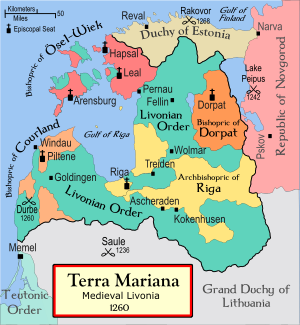Battle of Wesenberg (1268)
| Battle of Rakvere | |||||||
|---|---|---|---|---|---|---|---|
 Map showing the location of the Battle of Rakvere in the context of the 13th century Livonia. |
|||||||
|
|||||||
| Belligerents | |||||||
|
Pskov Republic Novgorod Republic |
Livonian Order | ||||||
| Commanders and leaders | |||||||
|
Daumantas of Pskov Dmitry of Pereslavl |
Alexander of Dorpat† Otto von Lutterberg |
||||||
| Strength | |||||||
| 16,000 — 30,000 troops | 25,000-30,000 troops | ||||||
| Casualties and losses | |||||||
| 5,000 troops | 12,000 troops | ||||||
The Battle of Wesenberg, Rakvere or Rakovor was a battle fought on February 18, 1268, between the Livonian branch of the Teutonic Knights and a coalition of Russian princes. Medieval accounts of the battle vary, with both sides claiming victory, such that the other was unable to mount further attacks. The most likely conclusion is that the battle was a tactical draw, with both sides withdrawing, badly bloodied, to defend their own lands.
The two armies clashed within 7.5 kilometers (roughly 4.5 miles) from the Livonian town of Wesenberg (Rakvere, Rakovor). Russian forces, numbering up to 30,000 troops, were led by Dmitry of Pereslavl (representing the Novgorod Republic) together with his future son-in-law, Daumantas of Pskov (representing the Pskov Republic).
Apart from the knights, the Livonian army included Danish forces (right flank) and local Estonian militia (left flank). It is unclear who the overall commander of the crusading army was, as some sources claim that Livonian Ordensmeister Otto von Lutterberg was not present, while others claim he was. Bishop Alexander of Dorpat was likely one of the army's leaders, however.
The Livonian forces deployed in their customary deep "boar's head" wedge of heavily armoured knights, called by the Russians the "great iron pig." These deep wedges had considerable penetrative power, but were unmaneuverable and vulnerable to flank attack due to the resulting narrow frontage of the army, facts which led to the ultimate defeat of the Knights at the Battle of Lake Peipus. As a result, the Livonians attempted to remedy this situation at Rakvere by splitting their knightly assault force into two formations, deploying one wedge in the open and a second in ambush, so that when the first wedge was attacked on all sides by the Russians the second wedge would burst from ambush and in turn encircle the enemy.
...
Wikipedia
